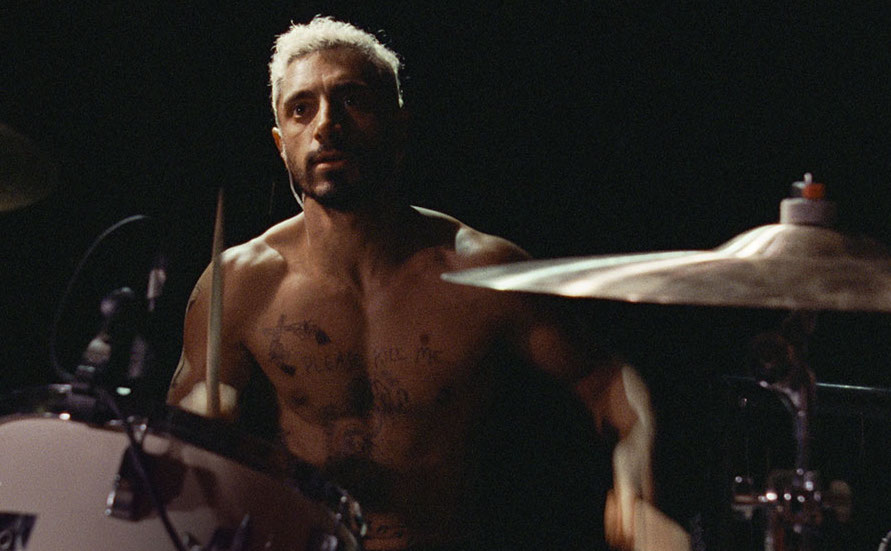Sound of Metal, the debut feature film from writer/director Darius Marder, is a sensory experience. It follows Ruben (Riz Ahmed), a drummer in a punk-metal duo with his long-term girlfriend Lou (Olivia Cooke). When he abruptly loses the majority of his hearing, Ruben has to reckon with what the sudden deafness means for his relationship, his future, and his identity as a musician. The film utilizes complex sound design (the sound mixing alone was a 20-week process) to represent Ruben’s hearing loss, progressing from Lou’s screeching vocals to muffled silence to the staticky din of the world filtered through cochlear implants.
This isn’t just about wowing the hearing audience with the film’s technology, but immersing them into the terror and disorientation of Ruben’s sudden impairment. “The film is very much about asking us, societally, what is it like for us as hearing people to merge into a culture where we are suddenly the minority,” Marder says to the Voice.
Sound of Metal is at once accessible and inaccessible. It is open captioned, meaning subtitles are burned into the actual film, yet several scenes contain muffled voices or ASL without captions. Ruben, and a hearing audience who are placed in Ruben’s POH (or point of hearing, a phrase Marder uses), are “learning to be deaf.” More than just accepting his condition, Ruben is discovering what it is like to live in an ableist world and building community with others similar to himself.
The issues of accessibility Ruben faces on-screen parallel issues of accessibility in movie theaters across the country. Opening captioning for mainstream (non-foreign language) films by studios is rare, even when these films contain deaf representation, Marder points out. “Think about a film like A Quiet Place, which pats itself on the back for having a real deaf person in it, and doesn’t caption the movie. Think about what that means.” In addition, many movie theaters don’t have the technological or monetary means to provide closed caption screenings of films, making these spaces inaccessible for d/Deaf and HOH (hard-of-hearing) audiences.
Marder adds that A Quiet Place, as a recent example of mainstream deaf representation, fails the community it purports to represent by primarily making itself available for hearing audiences: only the ASL was open captioned. “You’re going to put a deaf person in your movie, and then not allow deaf people to come and watch that same movie?” With Sound of Metal, he sought to make representations of Deaf culture available to a hearing audience, while centering d/Deaf and HOH audiences by prioritizing open captions.
Much like Sound of Metal’s protagonist, however, Marder approached Deaf culture as an outsider. “This is a movie from the perspective of a hearing person. In other words, this isn’t a movie about Deaf culture. It would be preposterous for me to make a movie about Deaf culture because I’m not of that culture,” he says.
Instead, Marder sought to have Deaf culture represent itself. Every d/Deaf character in the film—with the exception of Ruben—was played by an actor who is a part of the Deaf community, including Paul Raci, a CODA (Child of Deaf Adults), and one of Sound of Metal’s standout performances. Raci plays Joe, who is a Vietnam veteran that lost his hearing in a bomb explosion and a counselor for recovering addicts. Ruben meets him while staying at a secluded Deaf community, where he learns to communicate through ASL while preventing a relapse of his heroin addiction. Along with the ensemble of other d/Deaf actors who play members of this community, Raci brings an indispensable authenticity of experience to the film.
Marder, as a hearing person, acknowledges that he is not the first person to raise concerns about representation and accessibility within the film industry: “It’s also important to say that I am not at the forefront of this movement. I [advocate for open captioning] with great humility because there are people working on open captions and have been for years.” But he hopes Sound of Metal can bring some of the conversations from within the Deaf community to a broader stage—and to the attention of able-bodied viewers who may usually overlook these issues.
For that reason, Marder had hoped for a theatrical release that current circumstances have made impossible. “As an online experience, you cannot have that sense of cross-cultural experience in the same way,” he says. “I’ve been in the theaters with large deaf audiences and hearing audiences. You can hear and feel two different cultural perspectives happening at the same time.”
These spaces that bring us together for dialogue and reflection, like theaters, have been one of the most difficult casualties of the COVID-19 pandemic. Yet, through its experiential sound design and overwhelmingly empathic portrayal of addiction and disability, Sound of Metal serves as a reminder of how art can pluck each of us from our bubbles of isolation and connect us to the world again.
Sound of Metal is available now to stream on Amazon Prime.





